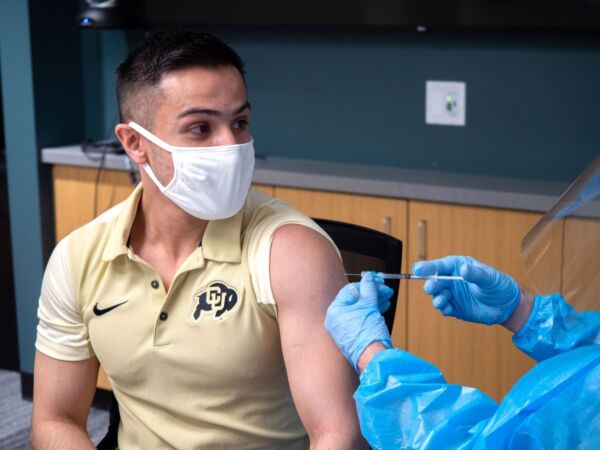The Evolution of the COVID-19 Vaccines
By Amir Kalani
Over one year ago, CU Boulder sent out an email to the entire student body, indicating that campus would be mostly closing due to a worldwide pandemic of SARS-coV-2, the virus that is responsible for COVID-19. This began one of the hardest and confusing years for many. Flash-forward to now, and we are still in that position, although recovering. Fortunately, due to the development of the COVID-19 vaccine from companies like Pfizer, Moderna and Johnson & Johnson, we are nearing the end of the pandemic that we have grown accustomed to.
The development and production of the vaccine has come at staggering speed compared to normal vaccine developments, which on average take 10 to 15 years. Vaccine development is an intensive process that consists of research, development, pre-clinical trials, clinical trials and mass production. Prior to the COVID-19 vaccine, the fastest developed vaccine was the mumps vaccine in the late 1960’s. This record was shattered by over 400%, and unlike the mumps vaccine, researchers had no prior knowledge of the disease before developing the COVID-19 vaccine.
The pace of development is astonishing but worrying to many. However, when you look at the tools and resources available before the pandemic, and over the course of it, it’s quite evident how multiple companies were able to get us where we are now, safely.

Getting a Head Start
Early bird gets the worm—and out of the pandemic faster. This is why the development of the vaccine began even before global outbreaks. The DNA sequence of the SARS-coV-2 virus was published on January 11, 2020, just 10 days after the first hospitalized pneumonia cases in Wuhan, China. This was a vital piece of information for developing vaccines. At this point, the small initial outbreak had begun in Wuhan, but as many of us recall, the rest of the general public was unaware or not worried by the situation. Fortunately, the scientists and virologists at Moderna, Pfizer and other pharmaceutical companies immediately began battling COVID-19 in their laboratories. Back then, COVID-19 wasn’t even in our day to day thoughts until mid-March of 2020. However, at that point, four companies had already entered into human trials of their brand new vaccine candidates.
Coronaviruses
SARS-coV-2 is a type of coronavirus, and there are many more. Lots of the common cold perpetrators are types of coronaviruses. There are also more serious coronaviruses like Middle Eastern Respiratory Syndrome (MERS) which had an outbreak in 2012 and 2013. There had already been heaps of research performed on these viruses, and many labs specialize in only coronavirus. There were vaccines developed for these other coronaviruses and platforms ready to take on the next. So, as soon as COVID-19 began to spread across the world, there had already been these resources and platforms itching to be used.
Dr. Eric Yager, a professor of microbiology at the Albany College of Pharmacy and Health sciences, in an interview with Medical News Today said, “Research on these viruses established the importance of the viral spike (S) protein in viral attachment, fusion, and entry, and identified the S proteins as a target for the development of antibody therapies and vaccine.” All the scientists had to do was make minor tweaks and adjustments to tailor it specifically for COVID-19.
mRNA Vaccines
As many of us have heard, the two main vaccines from Moderna and Pfizer are ‘mRNA’ vaccines. These vaccines are the first of their kind, as there has never been an ‘mRNA’ vaccine before. How did we go from never having a vaccine of this type back then, to it now being the leading vaccine platform for the fastest vaccine development in history?
Similar to the research with the prior coronaviruses, mRNA vaccine research and development has been in progress for the last half of a decade. However, it had yet to be deployed for a mass vaccine. The benefit of this vaccine platform is that it only carries the most important protein, the ‘spike’ protein Dr. Yager previously mentioned, that is used by the virus to infect your cells. Also, the mRNA is a sequence of ‘letters’ just like the sequence of DNA, so when the DNA map of COVID-19 was released, all Moderna and Pfizer had to do was find the small section that coded for this spike protein and make it. This platform is quick to produce once you have this sequence, and it is just as safe as previous types of vaccines which tend to rely on injecting a full but inactivated or harmless virus, otherwise described as an adenovirus platform.
It has not been an easy road for anyone for the last year. Many of us did not think it would be this long or hard to return to a “normal” life. With the prompt development of the vaccine and its emergency approval, we are now leading our final push out of the pandemic. According to the Bloomberg Vaccine Tracker, the United States administered 3.35 million vaccine doses each day over the course of the last week. At this rate, is it expected to take another 3 months until the United States reaches a population immunity of 75%. This threshold is what Dr. Anthony Fauci estimates is the ‘return to normal’ level. The transition from being just an idea over a year ago to being at the mass distribution levels we are now and approaching the vaccination threshold, is quite the feat of science, technology and global collaboration.

